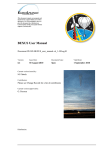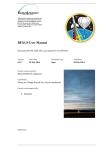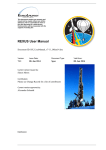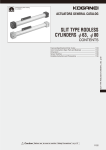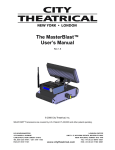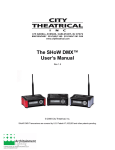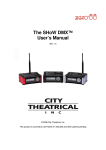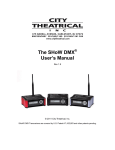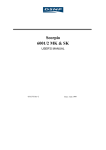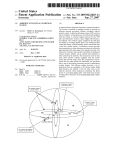Download BEXUS User Manual
Transcript
Published 2007-12-11 This document remains our property and should not be copied without our written allowance. Nor is it permitted to show or give this document to a third person. Contravention will be prosecuted with the support of existing law. BEXUS User Manual Document ID: BX00-07-12-11 BEXUS Manual 4.4.doc Version: Issue Date: Document Type: 4.4 11. November 2007 Spec Issued by: ........................................................................ Olle Persson, Harald Hellmann, A. Stamminger Approved by: ........................................................................ Olle Persson Distribution: Valid from: Page 2 Change Record Version Date Changed chapters Draft ver 2 Vers 3 4.1 4.2 4.3 070207 070823 071123 071130 071205 0712011 all all Abstract: - Keywords: - File: Printed: Last saved: Mall: act_request_doc_85426.DOC 2007-12-11 10.51 2007-12-11 10.50 Std-01-e.dot Remarks O. Persson O. Persson Page 3 Table of Contents 1 INTRODUCTION........................................................................................................ 6 1.1 Definitions........................................................................................................... 7 1.2 References........................................................................................................... 7 1.3 Abbreviations ...................................................................................................... 8 2 BEXUS PROJECT OVERVIEW AND MILESTONES ........................................... 10 2.1 Project Organisation.......................................................................................... 10 2.2 Project Planning ................................................................................................ 10 2.2.1 Project Phases [Ref [1]]:..................................................................... 11 2.2.2 General BEXUS Timetable ................................................................ 11 2.3 BEXUS Flight Ticket........................................................................................ 11 2.4 Student Experiment Documentation SED ........................................................ 12 2.5 Mission Flight Handbook - MFH ..................................................................... 13 3 BEXUS SYSTEM ...................................................................................................... 14 3.1 BEXUS flight configuration ............................................................................. 14 3.1.1 Homing Aid ........................................................................................ 15 3.1.2 ATC transponder ................................................................................ 15 3.2 Flight sequence ................................................................................................. 15 3.2.1 Flight Profile ....................................................................................... 16 3.2.2 Recovery ............................................................................................. 17 3.2.3 Performance ........................................................................................ 17 4 MECHANICAL DESIGN OF EXPERIMENTS ....................................................... 18 4.1 Loads during launch, flight and recovery ......................................................... 18 4.2 Acceleration ...................................................................................................... 18 4.3 Landing velocity ............................................................................................... 18 5 ELECTRICAL DESIGN OF EXPERIMENTS ......................................................... 19 5.1 General .............................................................................................................. 19 5.2 E-Link Telemetry system.................................................................................. 19 5.2.1 E-Link System Overview ................................................................... 19 5.2.2 Technical Specification of the E-Link Airborne Unit ........................ 20 5.2.3 Technical Specification of the E-Link Ground Unit........................... 20 5.3 Interface Description for E-Link Experiment Channels ................................... 21 5.3.1 Electrical interface .............................................................................. 21 5.3.2 Connector description ......................................................................... 21 5.3.3 Connector pin-out (E-Link Main Unit)............................................... 21 5.3.4 Connector pin-out (E-Link Interface Unit)......................................... 22 5.3.5 Connector pin-out (E-Link Interface Unit)......................................... 22 Page 4 5.4 Esrange Balloon Service System - EBASS ...................................................... 23 5.4.1 EBASS Overview ............................................................................... 23 5.4.2 Technical Specification of the EBASS Ground Unit ......................... 24 5.4.3 Technical Specification of the Airborne Unit..................................... 25 5.4.4 Interface Description for EBASS Experiment Channels.................... 26 6 THERMAL DESIGN OF EXPERIMENTS .............................................................. 28 6.1 The BEXUS Thermal Environment.................................................................. 28 6.1.1 Pre-Launch Phase ............................................................................... 28 6.1.2 Count Down Phase ............................................................................. 28 6.1.3 Flight phase......................................................................................... 28 6.1.4 Post-flight phase ................................................................................. 28 6.2 Electro-Magnetic Compatibility ....................................................................... 28 7 EXPERIMENT REVIEWS AND TESTS ................................................................. 29 7.1 Preliminary Design Review, PDR .................................................................... 29 7.2 Critical Design Review, CDR........................................................................... 29 7.3 Progress Report / Mid Term Report.................................................................. 29 7.4 Experiment Acceptance Review, EAR ............................................................. 29 7.4.1 Electrical Interface Test - EIT ............................................................ 30 7.4.2 Flight Simulation Test - FST .............................................................. 30 7.5 Flight Acceptance Review - FAR ..................................................................... 30 7.6 Flight Readiness Review - FRR........................................................................ 31 7.7 Additional Tests ................................................................................................ 31 7.7.1 Vacuum test ........................................................................................ 31 7.7.2 Thermal test ........................................................................................ 32 8 BEXUS LAUNCH CAMPAIGN............................................................................... 33 8.1 Balloon Launch Conditions .............................................................................. 33 8.2 Description of Esrange Space Center ............................................................... 33 8.3 Assembly of balloons and payloads.................................................................. 33 8.3.1 Assembly of balloons ......................................................................... 33 8.3.2 Assembly and checkout of payloads................................................... 33 8.4 Countdown and Launch .................................................................................... 33 8.5 Recovery ........................................................................................................... 34 9 EXPERIMENT QUALITY ASSURANCE ............................................................... 36 9.1 Materials ........................................................................................................... 36 9.2 Components ...................................................................................................... 36 9.3 Additional quality topics................................................................................... 36 9.4 Personnel Safety................................................................................................ 37 9.5 Safety at Esrange Space Center ........................................................................ 37 Page 5 10 COORDINATE SYSTEM DEFINITION.................................................................. 38 10.1 Earth Centered, Earth Fixed (ECEF) ................................................................ 38 10.2 Local Tangential Coordinate System (LTC)..................................................... 40 Page 6 BEXUS User Manual 1 INTRODUCTION The Swedish/German balloon program BEXUS provides periodically recurring flight opportunities for student experiments. Conducted by EuroLaunch, BEXUS is an easily accessible experiment facility giving a couple of hours of high atmosphere flight. Figure 1-1: Esrange launch site The payload is modularised to provide simple interfaces, large flexibility and independence between experiments. All payload service systems necessary for telecommunication, payload control, recovery are included in the system. High speed telemetry and up-link command control of experiments can be provided on request. The BEXUS program is operational with a basic launch schedule of two launches every year. This document comprises all the necessary information for a user of the BEXUS system, including the services offered by EuroLaunch. It defines the requirements that applies to the BEXUS experiment modules and gives design recommendations. It also includes a description of the BEXUS system, the programmatic, a description of the tests and the campaign and, finally, a chapter on Quality Assurance and Safety. Page 7 BEXUS User Manual 1.1 Definitions The BEXUS system consists of the following components according to EuroLaunch definition. BEXUS The complete integrated vehicle to perform the flight. Ground Equipment BEXUS supporting systems on ground. EBASS Balloon service system. E-Link Ethernet up & downlink ESRANGE Facilities Equipment used to monitor and control the flight, and telemetry receiving equipment. Ground Support Equipment Equipment used to control and communicate with various modules during test and count down. 1.2 Balloon The parts of BEXUS giving the lifting force. Payload Experiment modules and all subsystems. Subsystems All systems required for flight control, recovery and telemetry. Experiment Gondola Experiment equipment and the carrier structure. References [1] European Cooperation for Space Standardization ECSS: Space Project Management (ECSS-M-30A, 1996) [2] Montenbruck, Oliver / Gill, Eberhard: Satellite Orbits (Springer Verlag, 2000) [3] SSC Esrange: EU A00-E538 Esrange Safety (Esrange, www.ssc.se/esrange) [4] SSC Esrange: User’s Handbook (Esrange, http://www.ssc.se/esrange) [5] Vallado, David A.: Fundamentals of Astrodynamics and Applications (McGrawHill Companies, Inc, 1997) Page 8 BEXUS User Manual 1.3 Abbreviations AIT AGT APID asap ATC BEXUS CDR DLR EAT EAR EBASS ECEF EGon EIT E-Link EMC EMI ESA ESRANGE FAR FST FRP FRR GSE HERCULES HCD HK H/W ICD I/F IFU LT LOS LTC Mbps MFH MORABA MTR NCR PCM Assembly, Integration and Test Argos GPS and ATC Transponder Application Identifier as son as possible Air Traffic Control Balloon EXperiment for University Students Critical Design Review Deutsches Zentrum für Luft- und Raumfahrt Experiment Acceptance Test Experiment Acceptance Review Balloon piloting system Earth Centered, Earth Fixed ESRANGE balloon gondola Electrical Interface Test Ethernet up & downlink system Electro-Magnetic Compatibility Electro-Magnetic Interference European Space Agency European Sounding Rocket Launching Range Flight Acceptance Review Flight Simulation Test Flight Requirement Plan Flight Readiness Review Ground Support Equipment Balloon launch vehicle Hot Countdown House Keeping Hardware Interface control document Interface Interface Unit Local Time Line of sight Local Tangent Coordinate System Mega Bits per second Mission Flight Handbook Mobile Raketenbasis (DLR) Mid Term Report Non Conformance Report Pulse Code Modulation Page 9 BEXUS User Manual PDR PFR PI PST QA RNRZ SNSB SED SSC STW S/W T TBC TBD TC TM WGS84 Preliminary Design Review Post Flight Report Principal Investigator Payload System Test Quality Assurance Randomized NRZ (a signalling modulation) Swedish National Space Board Student Experiment Documentation Swedish Space Corporation Student Training Week Software Time before and after launch noted with + or To be confirmed To be determined Telecommand Telemetry World Geodetic System 1984 Page 10 BEXUS User Manual 2 BEXUS PROJECT OVERVIEW AND MILESTONES 2.1 Project Organisation The technical support in the integration and testing phase, as well as the campaign management and operations is provided by EuroLaunch. EuroLaunch was founded in 2003 and is a joint venture of Esrange (Swedish Space Cooperation SSC) and the Mobile Rocket Base MORABA (German Aerospace Center DLR). The DLR service part concerning integration, testing and student support is provided by the Institute of Space Systems RY (DLR) in Bremen. When in this document EuroLaunch is mentioned this means that all three institutions (Esrange, MORABA and the RY) may be involved. The BEXUS balloons are launched at the European Sounding Rocket Launching Range Esrange of SSC, near Kiruna in North-Sweden. The scientific evaluation of the experiment proposals and the financial support of the students are in the responsibility of the German Space Agency (DLR) and the Swedish National Space Board (SNSB) through cooperation with the European Space Agency (ESA). At EuroLaunch the following key-positions will be assigned for every flight project: - Project manager - System manager - Mechanical design responsible - Electrical design responsible - Telemetry (TM) and Telecommand (TC) systems responsible Additional positions will be assigned if necessary. 2.2 Project Planning The detailed project planning and time schedule will be released by EuroLaunch for each flight at the first workshop. This information will be adopted into the Mission Fligth Documentation (MFD). Page 11 BEXUS User Manual 2.2.1 Project Phases [Ref [1]]: Phase A: Feasibility Phase, ends with Form B and the presentation at the workshop Phase B: Preliminary Design study phase, ends during the student training week with the Preliminary Design Review (PDR) Phase C: Detailed Definition Phase, ends with the Critical Design Review (CDR) Phase D: Production and Qualification Phase, ends with the Experiment Acceptance Review (EAR). The phases C and D are generally inseparable, owing to the integrated nature of the activities. Phase E: Launch and operation (campaign) Phase F. Post flight analysis and final report 2.2.2 General BEXUS Timetable T - Time before and after launch, m - month T-11 m Call for Experiment Proposals T- 9 m Experiment Submission Deadline T- 8 m Preliminary experiment selection T- 7 m Workshop in ESTEC (ESA) / Bonn (DLR); experiment presentation T- 6.5 m Final experiment selection T- 5 m Student Training Week (STW) at Esrange or Bremen Preliminary Design Review (PDR), Start of phase D 2.3 T- 4 m Critical Design Review (CDR) T-2.5 m Mid Term Report (MTR) T- 1 m Delivery of Experiments to Esrange (ESA) / Bremen (DLR), EAR T Campaign at Esrange T+1 m Distribution of the BEXUS Post Flight Report (PFR) T+3 m Submission of final Student Experiment Reports T+ 4 m Submission of Final Report BEXUS Flight Ticket In the BEXUS “flight ticket”, which is offered to the international student community, the following services are included: - General management and planning of the BEXUS project - Provision of launch vehicle and subsystems necessary for a flight mission of 2-5 hours with recovery. Page 12 BEXUS User Manual 2.4 - Integration of participating modules into the flight configured payload and testing of payload (TM, TC, flight simulation test, dynamic balancing, vibration tests and determination of physical properties). - Transport of modules from the integration facility to Esrange. - Payload assembly and testing at Esrange launch site - Provision of laboratory facilities at Esrange launch site. - Launch and recovery. - Data acquisition with provisions of real time, quick-look and replay data from gondola and payload subsystems. - Disassembly of recovered payload and return of experiments. - BEXUS post flight report. Student Experiment Documentation SED Once selected every experiment team will receive a SED blank book. Each student team will document their experiment setup, the experiment components, interfaces, technical data and the flight requirements in the SED. This SED will be a living document during the project. At the end of different project phases the SED should have a certain status. The SED will be used as a required documentation for the PDR, the CDR and the MTR. There will be a Flight Requirement Plan (FRP) which is part of the SED. The FRP defines the mission requirements and also the services to be provided by EuroLaunch. It is recommended that details of the document are communicated in advance in order not to violate rules and regulations mentioned in the Esrange Safety Manual [Ref [3]]. The due date for the final version of this document is before launch. Once selected every experiment team will receive a SED blank book. After the delivery of the experiment hardware there will be several tests. These tests are performed in accordance with an established test plan and test procedure. The results are documented in test reports and presented during the following review. Any non-conformances discovered during the tests shall be recorded in a NonConformance Report (NCR). The test procedure shall contain: - Scope of the test, referring to requirement in specification to be verified - Test conditions - Test equipment and set-up - Step-by-step procedures - Recording of data - Success Criteria All test report, action item lists and NCRs shall be attached to the SED. Page 13 BEXUS User Manual 2.5 Mission Flight Handbook - MFH After the experiment presentation at the first workshop there will be a Kick-off meeting of the BEXUS mission. In this meeting the experiments and the mission parameters will be defined and published in the first version of the Mission Flight Handbook (MFH). The MFH is a document which is prepared by EuroLaunch. It contains all information and requirements which are necessary for preparation and performance of the balloon flight as well as a short description of the BEXUS payload. The first version of the MPH will be distributed to all participants asap after the Kick-off Meeting. In the beginning of the launch campaign there will be a Campaign Handbook. All important information of the MFH, the nominal trajectory and updated vehicle parameters will be frozen in the Campaign Handbook at begin of the campaign. A Post Flight Report with the flight events and trajectory data will be distributed as soon as possible after launch. All three documents will be provided by EuroLaunch. Page 14 BEXUS User Manual 3 BEXUS SYSTEM 3.1 BEXUS flight configuration A typical BEXUS configuration consists of a 12.000m3 balloon, a cutter, a parachute system, the Esrange Balloon Service System (EBASS), the flight train Argos GPS and ATC Transponder (AGT), a radar feflector and an experiment gondola (Figure 3-1). Figure 3-2: BEXUS Experiment Gondola Figure 3-1: BEXUS Vehicle Figure 3-3: Hercules Launch Vehicle with Gondola Page 15 BEXUS User Manual 3.1.1 Homing Aid Flight train and balloon envelope are equipped with separate ARGOS/GPSreceiver/transmitters (AGT) from which the position information can be assessed by satellite both during flight and after landing. The GPS-position is also transmitted via the telemetry stream through the EBASS system. The recovery team in the helicopter can be equipped with a homing-receiver in order to acquire the GPS-position for quick and easy localisation of the payload. The payload is normally brought back to Esrange within a day or two after launch. 3.1.2 ATC transponder Both the balloon envelope and the payload are equipped with an air traffic transponder and altitude encoder. 3.2 Flight sequence Figure 3-4: Dynamic Launch with Hercules Launch Vehicle Page 16 BEXUS User Manual 3.2.1 Flight Profile 3 4 5 7 6 1. Launch 2. Ascent 3. Float 4. Open Valve 2 5. New float 6. Ballast release 8 7. Cut Down 8. Parachute descent 1 9 9. Impact Figure 3-5: BEXUS Flight Profile The performance of the BEXUS balloon may be adapted to the respective mission requirements. Ballast and valve operation is optional and not normally flown on BEXUS Figure 3-6: Flight Trajectory Example of BEXUS-5 (March 2007) Page 17 BEXUS User Manual 3.2.2 Recovery The recovery is by parachute and the gondola will be picked up by helicopter for further transport by truck back to Esrange. Figure 3-7: Recovery of BEXUS-5 3.2.3 Performance The experiments are placed in the payload gondola which has a size of 1.45 x 1.45 x 1.2 m. The total possible mass of the experiments is between 40 and 100 kg. The payload mass influences the maximum altitude. Final altitude is calculated before launch and may vary between 25 to 35 km. Page 18 BEXUS User Manual 4 MECHANICAL DESIGN OF EXPERIMENTS It is a requirement that the experiment modules are made either gas tight or equipped with venting holes. A configuration of an experiment gondola is shown below. At the bottom bulkhead there is a rail with adjustable fixating points Different types of mechanical interfaces between the experiment deck and the outer structure is possible. Figure 4-1: Gondola Figure 4-2: Exp. Mounting 4.1 Loads during launch, flight and recovery The experiment should be structured to withstand the loads mentioned below as well as the loads that will be applied during the integration tests. 4.2 Acceleration The maximal acceleration of the payload is: -10g vertically and +/-5g horizontally 4.3 Landing velocity The landing velocity is approximately 8 m/s. The shock at impact depends on the nature of the ground surface. Nominally, the landing is gentle with no damage on the experiments. Page 19 BEXUS User Manual 5 ELECTRICAL DESIGN OF EXPERIMENTS 5.1 General The electrical interfaces between the experiments are limited to data and command wires connecting each experiment to the Esrange Airborne Data Link (E-Link) or the Esrange Balloon Service System (EBASS). An electrical cabling scheme will be prepared for each payload configuration. Battery power is to supply by the experimenter. If a user needs a power system he/she is responsible for the charging and measurement of batteries via umbilical lines. Batteries must be tested or certified to handle low pressure and temperatures. Esrange uses the SAFT brand of batteries. We have found them to perform well on balloon flights. There are other brands that also are possible to use, but it is wise to contact the project manager for advice. If Lithium batteries are used they must be easily removable from the payload, since they may explode and if so produces toxic fumes. Recommended batteries: Single use: SAFT LSH Series, (Lithium-thionyl chloride) Rechargeable: SAFT Li-ION, Nickel Cadmium or Nickel Metal Hydrid series. 5.2 E-Link Telemetry system Esrange Airborne Data Link (E-Link) is a telemetry system that offers the customer a simplified use with a standard Ethernet interface. It can handle TCP/IP and UDP/IP communication with high bandwidth across long distances. The system handles also other type of synchronous and asynchronous user interfaces. 5.2.1 E-Link System Overview The E-Link system consists of a ground station and an airborne unit: – Ground station consists of antenna, antenna control and Monitor & Control Unit – Airborne system includes antenna, battery, main, RF and interface unit The main features of the system are: • Standard and easy to use interface for payload, Ethernet 10/100 Base-T • High data bandwidth, 2 Mbps duplex nominal • Optional synchronous and asynchronous interfaces • Flexible and low weight of the airborne unit • Use of "hand-over" function offers a possibility to use several ground stations • All electrical parts are approved by FCC and ETSI (standards) Page 20 BEXUS User Manual Figure 5-1: E-Link Airborne Unit The E-Link airborne unit consists of RF-, control- and battery modules. 5.2.2 Technical Specification of the E-Link Airborne Unit Antenna: Vertical polarised omni Operating frequency: S-band Max output power: Peak 10 watt Modulation: DSSS Channel bandwidth: Nominal ±11 MHz Maximum range at LOS: 500 km at 30 km altitude (TBC) Data bandwidth: 2 Mbps duplex nominal User interfaces: – 2 Ethernet 10/100 Base – 3 asynchronous duplex RS-232/422 channels 5.2.3 Power supply: 20 to 38 volt DC Operation time: Nominal > 11 hours Weight: Nominal ~20 kg, including batteries Size including batteries: 320x250x250 mm, Size without antenna: 380x400x250 mm Technical Specification of the E-Link Ground Unit Technical specification of the ground station Antenna: 1.8 meter parabolic dish Operating frequency: S-band Max output power: Peak 10 watt Modulation: DSSS Page 21 BEXUS User Manual Channel bandwidth: Nominal ±11 MHz Maximum range at LOS: 500 km at 30 km altitude (TBC) Data bandwidth: 2 Mbps duplex nominal User interfaces: – Ethernet 10/100 Base-T – 2 asynchronous RS-232/422 channels – 1 synchronous channel up to 1 Mbps – 5.3 Interface Description for E-Link Experiment Channels Experiments can be connected to the E-Link system in two ways. If a maximum of two Ethernet channels are needed, the experiments can be connected to the Main Unit directly. If more Ethernet channels and/or some asynchronous serial channels are needed, the Interface Unit, IFU, of E-Link must be utilized. The IFU also provides one synchronous channel for PCM-type data. 5.3.1 5.3.2 5.3.3 Electrical interface Electrical levels: RS-232, RS-422, Ethernet and PCM Connector description Connector type: MIL-C-26482 series I, Connector pin-out (E-Link Main Unit) Function: Network Type: 10 pin Socket, Size 12 Orientation Normal CONN. PIN, FUNCTION ______________________________________________________________ A B C TX+ TXRX+ └E F ┌G RX- └H J K ┌D Page 22 BEXUS User Manual 5.3.4 Connector pin-out (E-Link Interface Unit) Function: Aux 1 Type: 8 pin Socket, Size 12 Orientation Normal CONN. PIN, FUNCTION ______________________________________________________________ A B C D E F G H 5.3.5 Network RS422 RS232 RXRX+ TXTX+ RX+ RXTXTX+ TX RX RTS CTS Signal GND Connector pin-out (E-Link Interface Unit) Function: PCM In Type: 8 pin Socket, Size 12 Orientation Normal CONN. PIN, FUNCTION ______________________________________________________________ A B C D E F G H RxData A RxData B RxClock A RxClock B Signal GND Page 23 BEXUS User Manual 5.4 Esrange Balloon Service System - EBASS 5.4.1 EBASS Overview The Esrange Balloon Service System, EBASS provides functions for: • Altitude control • Flight termination • Load cell controlled emergency termination • Onboard GPS • Housekeeping • Three full duplex, asynchronous, transparent serial connections for payload control and data reception Communication between EBASS and the ground station is maintained by a TM/TC-link at the 400 MHz-band. RF-receiver, -transmitter and -antenna are integrated parts of the system. The whole service system is enclosed by a glass-fibre armed insulation box. Figure 5-2: EBASS System with ballast machine to the left Page 24 BEXUS User Manual Figure 5-3: EBASS System Overview Data transmission is available for three payloads simultaneously. 5.4.2 Technical Specification of the EBASS Ground Unit Transmitting frequency: 449.,95 MHz Modulation: FM Total data bandwidth: 38.4 kbps Nominal Receiving frequency: 402,2 MHz Nominal (400-405 MHz) Modulation: FM Total data bandwidth: 38.4 kbps IF bandwidth: 50 KHz, 100 KHz 250 KHz and 500 KHz Output power: 100 Watt Antenna type: Helical Antenna Antenna polarisation: RHCP Antenna gain: 12dBic Maximum range: 550 km (at 30-km float & LOS) Page 25 BEXUS User Manual Figure 5-4: EBASS Ground System 5.4.3 Technical Specification of the Airborne Unit Figure 5-5: EBASS Airborne Unit Antenna type: Cross Broadband Dipole ) Maximum range: 550 km (at 30-km float & LOS) Transmitting frequency: 402.2 MHz Nominal(400-405 MHz) Modulation: FM Total data bandwidth: 38.4 kbps Nominal Receiving frequency: 449.95 MHz Modulation: FM Total data bandwidth: 38.4 kbps Nominal Output power: 100 Watt Operation time with maximum battery configuration: 40 hours Cut down system: Two independent, one is timer controlled Altitude control: Valve and ballast release Page 26 BEXUS User Manual 5.4.4 Interface Description for EBASS Experiment Channels Experiments can be connected to EBASS in two ways, either using a common connector for all experiments or by using a separate connector for each one of the experiments. 5.4.4.1 Electrical interface Electrical levels: RS-232 or RS-422 5.4.4.2 Connector description (EBASS common connector) Connector type: MIL-C-26482 series I, 16-26S, Orientation E 5.4.4.3 Connector pin-out (EBASS common connector) Function: Experiment Common Interface Type : 26 pin Socket, Size 16, Orientation E CONN.PIN, FUNCTION _____________________________________________________________ RS-422 RS-232 A Tx + Tx Expt. 1 B Tx C Rx + Rx D Rx E F G Gnd Gnd --------------------------------------------------------------------------------H Tx + Tx Expt. 2 J Tx K Rx + Rx L Rx M N P Gnd Gnd --------------------------------------------------------------------------------R Tx + Tx Expt. 3 S Tx T Rx + Rx U Rx V W X Gnd Gnd Y Z a b c 5.4.4.4 Connector description (EBASS separate connector) Connector type: MIL-C-26482 series I, 12-10S Page 27 BEXUS User Manual 5.4.4.5 Connector pin-out (EBASS separate connector) Function: Experiment 1 Interface Type: 10 pin Socket, Size 12, Orientation Normal CONN. PIN, FUNCTION _____________________________________________________________ A B C D E F G H J K RS-422 RS-232 Tx + Tx Rx + Rx - Tx Gnd Gnd Rx Function: Experiment 2 Interface Type : 10 pin Socket, Size 12, Orientation B CONN.PIN, FUNCTION _____________________________________________________________ A B C D E F G H J K RS-422 RS-232 Tx + Tx Rx + Rx - Tx Gnd Gnd Rx Function: Experiment 3 Interface Type : 10 pin Socket, Size 12, Orientation C CONN.PIN, FUNCTION _____________________________________________________________ A B C D E F G H J K RS-422 RS-232 Tx + Tx Rx + Rx - Tx Gnd Gnd Rx Page 28 BEXUS User Manual 6 THERMAL DESIGN OF EXPERIMENTS Experiments with high power dissipation (furnaces) result in a thermal interaction between the experiments. This might have to be considered when setting up the payload. 6.1 The BEXUS Thermal Environment 6.1.1 Pre-Launch Phase The preparation of the payload are made in normal room temperature 20±5 °C. After preparation, the payload is transported to the launch pad. The ambient temperature during the transport can be low (down to -15 °C), depending on the outdoor temperature, and the exposure time can be up to several hours. 6.1.2 Count Down Phase Experience shows that during count down, the experiment modules tend to see an increase in temperature over time, especially if long holds are required. Some actions can be taken at the launch pad to improve the situation, however it is recommended that heat sensitive experiment modules, or experiment modules that create high temperatures within the gondola, include temperature regulation in the experiment design. 6.1.3 Flight phase The thermal environment of the flight may see temperatures down to -90 °C. 6.1.4 Post-flight phase After the impact, the payload will be subjected to snow and cold air in the impact area for a period of typically one to two days. The temperature during the season when BEXUS is launched is normally between 0 °C and -15 °C. Experiments sensitive to low temperatures, must be designed for post flight conditions. 6.2 Electro-Magnetic Compatibility Radiated EMI The design shall be such that radiated EMI is kept as low as possible, it shall not interfere with other onboard systems. General guidelines of the design are as follows - All power supply cables shall be twisted. Data cables shall be twisted In case of EMI problems, shielding of the cables shall be considered. Page 29 BEXUS User Manual 7 EXPERIMENT REVIEWS AND TESTS 7.1 Preliminary Design Review, PDR The Preliminary Design Review (PDR) ends the study phase (phase A/B). It will be at the student training week. Minutes of meeting shall be written including an action item list. 7.2 Critical Design Review, CDR After the detailed design is finished the Critical Design Review (CDR) is performed. It will be about one month after the student training week at the end of phase C at a location TBD. After the CDR phase D starts with the hardware manufacturing. Minutes of meeting shall be written including an action item list. 7.3 Progress Report / Mid Term Report About two month after the CDR a Mid Term Report (MTR) has to be prepared by the experimenter. This report shall guarantee a satisfied work progress. The report shall also identify certain problems which are necessary to be solved prior to experiment delivery. In the report the experimenter shall present the following points: - Experiment development status - Time schedule compatibility - Experiment dimensions and weight - Identification of problems - List of hazard materials - Approach to solve problems - Interface compatibility 7.4 Experiment Acceptance Review, EAR The manufacturing phase D should end with the Experiment Acceptance Test (EAT) after delivery of the experiment. The EAT is similar to the Payload System Test (PST). Before experiment delivery it is recommended that: - Experiments have been qualified separately - Several functional tests of the experiment system have been performed to verify that the function is nominal at ambient condition - A test readiness review has been held, at which the experiment status, the test plan and test procedure have been presented and documented The EAT consist of: - Experiment checkout /functional tests Payload mass properties determination. Mechanical and electrical interface checkout Electrical Interface Test EIT Flight Simulation Test, FST The EAT is performed by EuroLaunch together with the experiment responsible student. Page 30 BEXUS User Manual 7.4.1 Electrical Interface Test - EIT The EIT will verify the compatibility of the interfaces and the functioning of the concerned hardware. Interface compatibility for critical signals, protection automatisms and voltage regulations will be checked systematically during assembly. Detailed procedures have to be defined for every unique module/subsystem. 7.4.2 Flight Simulation Test - FST The FST is the last test after successful performance of EAT checkouts and tests. When all experiments are operating nominally, a complete countdown and flight sequence is performed. All telemetry and telecommand signals will be recorded in the telemetry ground station, during the test. It is important that the changes/modifications are restricted to a minimum, done to H/W or S/W after the Flight Simulation Test. Non-conformances discovered during the test can of course be corrected, but care must be taken to verify that no further malfunctions are induced by the correction. The result of the EAT and all corrections after the FST shall be documented in a test report and shall be presented during the Flight Acceptance Review (FAR) Basic Procedure - The experiment shall be integrated and in flight configuration. The telemetry and telecommand checkout system or simulator shall be connected via the interface harness. - Experiment data shall be supervised and recorded during the test. - A nominal realistic count down procedure shall be followed, including at least one payload checkout. 7.5 Flight Acceptance Review - FAR Before the Experiment Assembly and Integration Test (AIT) the experiment shall have successfully passed the EAT: The experiment and subsystems will in due order be mated to the payload. All the mechanical and electrical interfaces will be checked and tested systematically during the assembly. After the assembly the AIT is conducted on the integrated BEXUS payload. It is performed at EuroLaunch premises. Nominally, this test starts two to five weeks before the planned start of the launch campaign. At the start of the AIT, all experiments comprising the BEXUS payload must be made available to EuroLaunch. During the AIT, the experiments must be in flight configuration. If use of dummies is required, this must be agreed by EuroLaunch. Upon completion of the AIT, the Flight Acceptance Review (FAR) will be held. The result from the AIT will be reviewed and problems discussed. The objective of the FAR is to obtain system acceptance and to authorise start of the campaign. Agreements shall specify whether to proceed on schedule or not, if the FAR is unsuccessful due to failure of any experiment. Page 31 BEXUS User Manual 7.6 Flight Readiness Review - FRR The FRR is conducted by the EuroLaunch coordinator at launch campaign and after successful completion of FAR and ground support stations checkout. The purpose of the FRR is to authorise start of the countdown phase In order to do this it is necessary to ensure that all experiments are ready for the flight. For this, each appointed experiment module manager shall give a status report at the meeting. In addition, the PI is requested to state the operative status of the experiment. to ensure that all ground and payload service systems essential for a successful launch, flight and recovery are operating nominally. For this each appointed system responsible shall give a status report at the meeting. to review the count down list to inform all relevant personnel of the safety regulations applicable during the count down phase. to inform all relevant personnel of general arrangements implied during the count down phase 7.7 Additional Tests 7.7.1 Vacuum test This test is applicable for experiment to be used under vacuum conditions, but is also applicable to verify that systems, mainly electrical, have nominal performance in absence of convective cooling. It is the responsibility of the experimenter to perform this test if necessary. Basic vacuum test procedure - The experiment shall be integrated and placed in a vacuum chamber (pressure below 0.5 mbar). - Experiment data shall be supervised and recorded during the test. - The experiment shall be operating during lowering of the pressure in the vacuum chamber. The module shall, if be in a similar mode as during the real flight of the BEXUS: - After the functional test/flight sequence has been performed it is recommended that the module is kept operating for 15 minutes to detect any leakage/overheating problems. Page 32 BEXUS User Manual 7.7.2 Thermal test Thermal test is mainly performed in order to verify a nominal function of the experiment during the worst case temperatures during countdown and launch. If needed this is done by the experimenter. The heating of the outer structure/gondola is normally not included or tested. Basic Procedure - The experiment shall be integrated and placed in a thermal chamber. The telemetry and telecommand checkout system shall be connected via the interface harness. - Experiment data shall be supervised and recorded during the test. - The temperature shall preferably be measured in several places in the experiment. - Low temperature test: Regulate the temperature in the thermal chamber to +10 °C. When the measured temperatures in the experiment have stabilised, perform a functional test/flight sequence. Be aware of condensation problems if the test is performed in normal humidity. - High temperature test: Regulate the temperature in the thermal chamber to +45 °C. When the measured temperatures in the experiment have stabilised, perform a functional test/flight sequence. During transition from low to high temperature, the module shall be operating and data shall be recorded. Page 33 BEXUS User Manual 8 BEXUS LAUNCH CAMPAIGN The BEXUS project manager provides Esrange Space Center, as well as all parties involved in the project, with the campaign handbook. This document comprises a description of the specific project such as payload data, list of hazardous materials, experiment requirements on launch operations, participants etc. 8.1 Balloon Launch Conditions Launch period: September / October Launch window: 05.00 – 20.00 LT Ground wind: less than 4 m/s. Conditions should be sufficient for helicopter recovery on the same day for a short flight and in other cases the next day. 8.2 Description of Esrange Space Center All the necessary information for a user of ESRANGE can be found in the ESRANGE Users’s handbook [Ref [4]]. Its main content is: - Range description (capabilities, layout, environment...) Range administration (communications, accommodation, freight, supplies...) Safety regulations Instrumentation (telemetry, tracking, observation, scientific...) Operations (assembly, checkout, flight control, recovery, requirements, procedures) Satellite facilities 8.3 Assembly of balloons and payloads 8.3.1 Assembly of balloons All assembling and preparations of the balloon and its subsystem are taken care of by the EuroLaunch launch team. 8.3.2 Assembly and checkout of payloads Payload assembly and preparations are conducted by the BEXUS project manager together with EuroLaunch staff. Working space in the launching area will be allocated by Esrange. 8.4 Countdown and Launch During the countdown phase important countdown information is displayed on “PA video monitors” at various locations of the launch site. The countdown phase may start with a test countdown if needed. It is normally executed during normal working hours. During a possible test countdown, all payload events up to take off shall be executed, late access activities shall be executed, all supporting ground facilities are operating. Dummy units may be used during the test countdown but requires EuroLaunch approval. Page 34 BEXUS User Manual Normally the countdown payload events start at 3 hours before launch. After completion of the preparatory work, the FRR is held. Pending the outcome of a test countdown, and the discussions during the FRR, the countdown list may be adjusted. Nominally, the first “Hot Countdown” is started the day after the test countdown. The nominal lift off time is planned for 05.00 to 20.00 local time. The launch window is determined by the payload preparation time, hold requirements and the time of daylight. The decision to start the countdown is taken at a weather briefing immediately before planned start of countdown. The decision is based on dedicated weather forecasts and wind data obtained by a weather balloon released from Esrange. If the weather conditions are unsuitable for launching the vehicle the launch will be delayed until the flight conditions are fulfilled. The general launch procedure may be subject to changes. A meteorological balloon will be launched to determine the flight conditions. A daily morning meeting concerning technical, scientific and meteorological conditions will be held in one of the conference room at Esrange. At this meeting a decision will be taken about the time of launch and the personnel involved will be informed. The schedule below indicates standard count down actions relative to launch (T = 0), Time (h:min) Action. T – 3:30 Decision meeting. T – 3:25 Start pad preparations. Start beacon & transponder tests. T – 3:00 Start E-Link tests. Start BEXUS preparation. T – 1:50 Start check of EBASS equipment. T – 1:10 BEXUS payload tests completed. Go from experimenters. T – 1:08 OK from EBASS and E-Link for unfolding of balloon. Second message to air traffic control. T – 0:45 Start balloon inflation. T= 0 Lift off. Continuous information to ATC's concerned throughout the flight. T + ~4:00 Command cut down followed by recovery. 8.5 Recovery The helicopter is equipped with tracking receivers for the payload beacon signal, and can also be equipped with a payload TM receiver for data reception of the payload’s GPS position. During the flight, the payload trajectory will be tracked by means of the transmitted GPSdata in the TM ground stations. During the descent of the payload, the prediction on the impact point co-ordinates is reported to the helicopter from Esrange. The helicopter starts their localisation operation after the impact. At the impact site, the helicopter crew disassembles the flight train for transport by truck back to Esrange. Page 35 BEXUS User Manual The whole operation is normally completed within two days after launch. After the recovery, a Post Flight Meeting is held to debrief the flight and a short flight performance report is stated. Page 36 BEXUS User Manual 9 EXPERIMENT QUALITY ASSURANCE EuroLaunch major concern of QA on experiment level is that the experiment shall fulfil the interface requirements and that the module can fly in a BEXUS payload without jeopardising the performance of the other systems or experiments. In addition, EuroLaunch has a strong concern that the experiments shall perform nominally. The following advice reflects these concerns. 9.1 Materials In addition to normal concerns when choosing materials, special attention shall be paid to out gassing phenomena due to vacuum environment during flight. As an aid the ESA-document PSS-07 (QRM-01) may be used. 9.2 Components All electrical and mechanical components must have a reliability that is consistent with the overall reliability of the payload. For electronic components, MIL-std specified types are recommended. 9.3 Additional quality topics In addition to the QA-topics above, the following topics shall be treated if required by EuroLaunch: - Procured products and audits Careful planning of the procurement and manufacturing must be made for identification of long lead items. Preferably, a flow chart shall be made which shows the sequence of operations. - Manufacturing control and inspection For the manufacturing and inspection of critical processes, the personnel should be certified in applicable areas, such as: • Manual soldering according to ESA PSS-01-708 • Crimping of connections according to ESA PSS-01-726 Specific requirements of the project or product concerning cleanliness, contamination and environment shall be stated in the Technical Specification. When positioning the parts or components, the sensitivity to, heating, ESD and electrical disturbances shall be considered. Connectors shall be well marked and preferably keyed - Re-used item It is important to consider the complete history of the re-used item, by consulting the hardware logbook or former project log-book; to be sure that it does not include any hidden failures. - Availability and Maintainability Page 37 BEXUS User Manual Spare parts for components susceptible of failure, shall be available during the payload AIT and the launch campaign. The design shall allow for easy and fast replacements of such components. - Handling, storage and packing ESD susceptible components shall be handled in ESD protected environment. Before transport, the product shall be thoroughly packed to withstand the expected loads. The use of a bump recorder is recommended. 9.4 Personnel Safety The BEXUS experiments and dedicated equipment must fulfil safety requirements according to Swedish law. The Swedish Work Environment Act is a general act that is backed up by special laws and regulations in different fields. The Swedish work environment authority issues these regulations. Special provisions apply (among others) to the following fields: Explosives Inflammable material Chemical hazards Electrical facilities Radiological work All the above mentioned laws and regulations are available at: www.av.se/inenglish/lawandjustice/workact The experimenter shall state that the module fulfils the applicable requirements and establish a list of hazardous materials, which shall be communicated to EuroLaunch no later than the MTR. This information shall always accompany the experiment. 9.5 Safety at Esrange Space Center The Safety Regulations that applies at Esrange may be found in Esrange Space Center Safety Manual [Ref [3]]. It is a requirement that all personnel participating in the campaign shall have read the safety regulation in Ref [3] prior to their arrival at Esrange Space Center. Page 38 BEXUS User Manual 10 COORDINATE SYSTEM DEFINITION This chapter will give a short overview on the coordinate systems that are used for the BEXUS onboard sensors, GPS and tracking systems. Knowledge about the coordinate definition and transformations is important for the analysis of sensor data during the flight and for the post flight analysis. The following table lists the used coordinate systems. Table 10-1 Coordinate Systems ECEF WGS84 LTC Earth Centered, Earth Fixed World Geodetic System 1984 Local Tangent Coordinate System The global reference system World Geodetic System 1984 (WGS84) is used for the BEXUS GPS position data. This system is based on the ECEF system. The Local Tangent Coordinate System (LTC) is important for observation of the rocket from Launcher, Tracking or Radar Station. Details are described in Ref [2]. 10.1 Earth Centered, Earth Fixed (ECEF) If a geocentric coordinate system rotates with the Earth, it results in Earth-Centered EarthFixed Coordinate System, abbreviated as ECEF. The main difference with this system is that the primary axis is always aligned with a particular meridian. The xECEF-Axis points toward the Greenwich-Meridian which is defined as longitude 0°. This coordinates system is rotating. The position of an object is defined with the geocentric Latitude φgc, which is measured positive in the North of the equator, the Longitude θ, which is measured positive in East direction from the Greenwich Meridian and the distance d from the Earth center. cos ϕ gc ⋅ cos θ xECEF r rECEF = yECEF = d ⋅ cos ϕ gc ⋅ sin θ z sin ϕ gc ECEF Eq. 10-1 Page 39 BEXUS User Manual Figure 10-1: ECEF Coordinate System The reference ellipsoid is rotation-symmetric and every plane cuts the ellipsoid to en ellipse with the flattening f⊕, which is defined with the relative difference of the equator and pole radius. f⊕ = R⊕ − RPole R⊕ Eq. 10-2 The WGS84 Ellipsoid has a flattening of f⊕ = 1 298.257223563 and the equator radius R⊕ is 6378137 m [Ref [2]]. The Earth eccentricity e⊕ can be calculated with following equation. e⊕ = 1 − (1 − f ⊕ ) 2 Eq. 10-3 The position of the Rocket is given in geodetic coordinates relative to the reference ellipsoid. The geodetic longitude θ corresponds to the geocentric longitude. Not like the geocentric latitude φgc, which is the inclination of the position vector to the equatorial plane, the geodetic latitude φgd describes the angle between equatorial plane and the normal to the reference ellipsoid. It is positive to the North and negative to the South. The difference of geodetic and geocentric latitude is shown in the following figure: Page 40 BEXUS User Manual Figure 10-2: WGS84 Reference Ellipsoid The flattening of the Earth is very small because the difference between the Earth radius at the equator and the poles is less than 22 km. Therefore the difference between geodetic and geocentric latitude is 12 minutes of arc. 10.2 Local Tangential Coordinate System (LTC) The LTC system rotates with the Earth. The E axis points to East, the N-axis points to the North and the Z axis is the zenith that is perpendicular to the tangential plane at the observation location (usually Launcher). This location is defined by the geodetic latitude φgd and geodetic longitude θ. Figure 10-3: Local Tangent Coordinate System (LTC) Two observation angles define the position of the Rocket from the observation location. The azimuth β is measured clockwise around the observation location starting in direction North. It varies between 0° and 360° and is calculated with following equation: Page 41 BEXUS User Manual east LTC northLTC β = arctan Eq. 10-4 The Elevation ε is measured between the horizon and the rocket position It varies between -90° and 90° and is calculated with the following equation: ε = arctan hLTC east 2 + north 2 LTC LTC Eq. 10-5 The transformation between azimuth and elevation to Cartesian LTC-coordinates is done with following equation: east LTC sin β ⋅ cos ε northLTC = d ⋅ cos β ⋅ cos ε h LTC sin ε Eq. 10-6 The distance d between the rocket and the observation location is also called Slantrange.









































